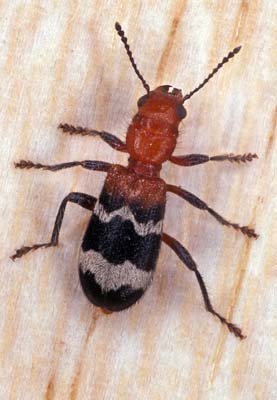
Adult Thanasimus dubius, a checkered
beetle.
(Photographer: James Castner,
University of Florida)
Male and female checkered beetles have long, hairy bodies that range from 0.3 cm to 2.4 cm in length. Many of these beetles are brightly colored, or sometimes all black with yellow or reddish-brown, hairy legs. The thorax of checkered beetles is usually narrower than the base of the forewings (elytra). The eggs of these beetles are small, white and cigar-shaped. The larvae can be either flat or round, and red or yellow in color. Larvae are also covered with hairs and have horny projections on the top of one of the body segments.
After mating, females lay their eggs in wood borer-infested trees in the cracks or crevices of the bark. Once the larvae hatch, they feed on wood-boring insects. The larvae then either pupate in the host cells, or make their way to the base of the tree and create a "cell" made from soil and glandular secretions. The larvae will then pupate, and emerge as adults.
Many checkered beetles are predaceous as both adults and larva, and are found on or in tree trunks and logs, on flowers and in foliage throughout the United States.
Checkered beetles feed on the larvae of wood-boring insects, such as the Asian longhorn beetle and the pine shoot beetle.
Images
To save the Web-optimized images shown below to your hard drive:
|
Click to access Display and Print quality images. |